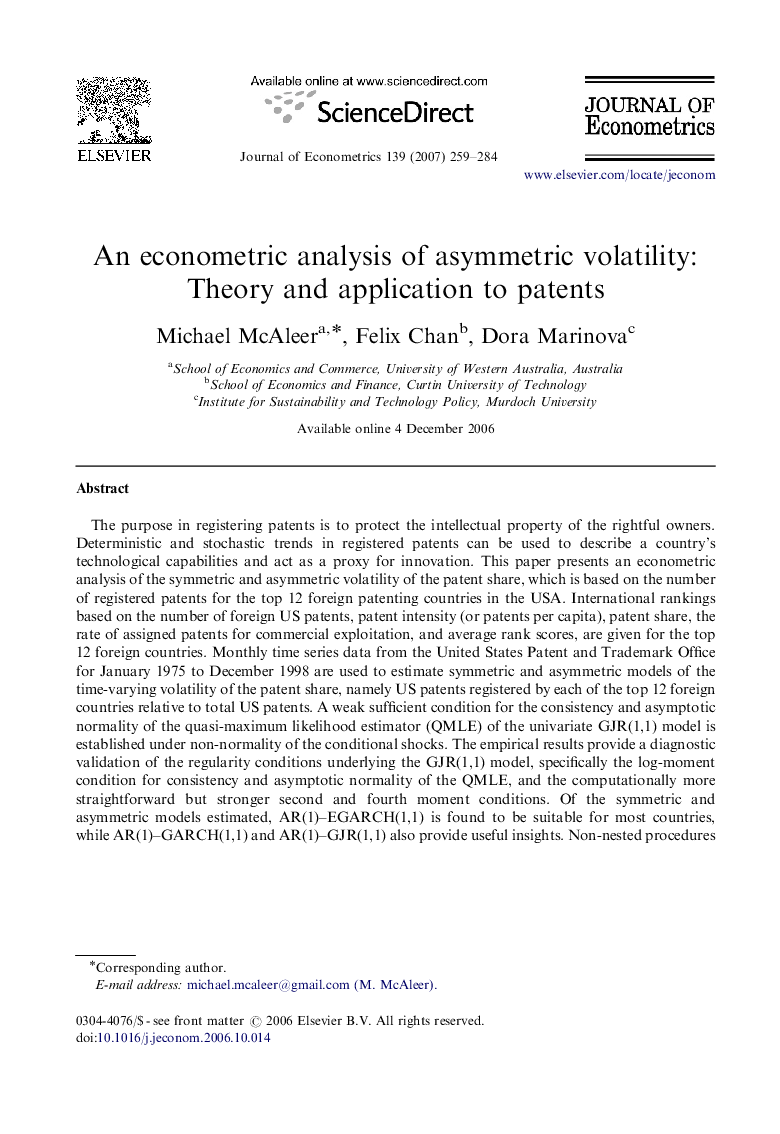| کد مقاله | کد نشریه | سال انتشار | مقاله انگلیسی | نسخه تمام متن |
|---|---|---|---|---|
| 5097454 | 1376590 | 2007 | 26 صفحه PDF | دانلود رایگان |
عنوان انگلیسی مقاله ISI
An econometric analysis of asymmetric volatility: Theory and application to patents
دانلود مقاله + سفارش ترجمه
دانلود مقاله ISI انگلیسی
رایگان برای ایرانیان
کلمات کلیدی
موضوعات مرتبط
مهندسی و علوم پایه
ریاضیات
آمار و احتمال
پیش نمایش صفحه اول مقاله

چکیده انگلیسی
The purpose in registering patents is to protect the intellectual property of the rightful owners. Deterministic and stochastic trends in registered patents can be used to describe a country's technological capabilities and act as a proxy for innovation. This paper presents an econometric analysis of the symmetric and asymmetric volatility of the patent share, which is based on the number of registered patents for the top 12 foreign patenting countries in the USA. International rankings based on the number of foreign US patents, patent intensity (or patents per capita), patent share, the rate of assigned patents for commercial exploitation, and average rank scores, are given for the top 12 foreign countries. Monthly time series data from the United States Patent and Trademark Office for January 1975 to December 1998 are used to estimate symmetric and asymmetric models of the time-varying volatility of the patent share, namely US patents registered by each of the top 12 foreign countries relative to total US patents. A weak sufficient condition for the consistency and asymptotic normality of the quasi-maximum likelihood estimator (QMLE) of the univariate GJR(1,1) model is established under non-normality of the conditional shocks. The empirical results provide a diagnostic validation of the regularity conditions underlying the GJR(1,1) model, specifically the log-moment condition for consistency and asymptotic normality of the QMLE, and the computationally more straightforward but stronger second and fourth moment conditions. Of the symmetric and asymmetric models estimated, AR(1)-EGARCH(1,1) is found to be suitable for most countries, while AR(1)-GARCH(1,1) and AR(1)-GJR(1,1) also provide useful insights. Non-nested procedures are developed to test AR(1)-GARCH(1,1) versus AR(1)-EGARCH(1,1), and AR(1)-GJR(1,1) versus AR(1)-EGARCH(1,1).
ناشر
Database: Elsevier - ScienceDirect (ساینس دایرکت)
Journal: Journal of Econometrics - Volume 139, Issue 2, August 2007, Pages 259-284
Journal: Journal of Econometrics - Volume 139, Issue 2, August 2007, Pages 259-284
نویسندگان
Michael McAleer, Felix Chan, Dora Marinova,